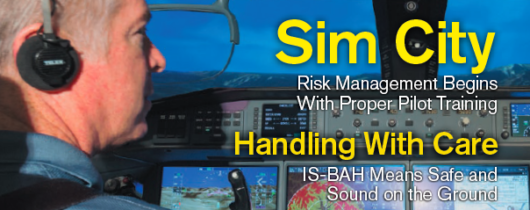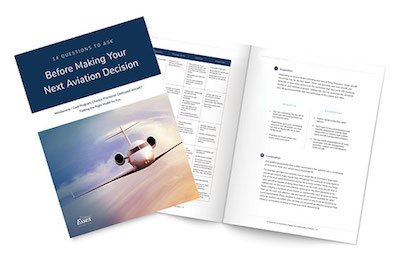
When it comes to safeguarding your most valuable assets, finding the right insurance policy is essential. Private jet ownership is no different; aviation insurance protects against the unique potential risks and liabilities associated with private aircraft ownership and operation.
It’s a common misconception that a private aircraft will be covered under homeowners or auto insurance — this is not the case! Read on for some key details to be aware of when researching and selecting a private jet insurance policy.
Understanding Private Jet Insurance
A private jet insurance policy typically includes three main components that cover a range of risks:
- Hull coverage protects against damage to the aircraft.
- Liability coverage protects against injuries sustained by the passengers or crew while the aircraft is in use.
- Secondary coverage can extend to loss of use, spare parts inventory, hangar keepers’ liability, rental parts, use of non-owned aircraft and other potential sources of risk.
In addition to the standard coverage options, some private jet owners may choose supplemental coverage for hangar storage or international travel. Owners and operators can customize their policies to suit their specific needs.
Private jet insurance is a critical investment for individuals or companies in possession of these high-value assets, since it provides peace of mind and financial protection in case of unforeseen events or accidents.
Factors Affecting Private Jet Insurance Costs
In addition to the coverage limits selected, the cost of private jet insurance varies based on several factors, including:
- The type and value of the aircraft: As with vehicles, the higher the aircraft’s retail price point, or value, the higher the insurance premium.
- The pilot’s level of experience: In addition to a satisfactory number of hours of flying experience, pilots should have received training within the past six months on any aircraft they intend to fly. A pilot should complete simulator training on relevant makes and models at least once a year. However, there may be such a thing as too much experience — pilots approaching 65–70 are nearing retirement age in the insurance underwriter’s perspective, which means the owner will need to work with their insurance carrier to outline their near term succession plans for the crew and, as such, could face higher insurance premium rates and or operational limitations.
- The intended use of the jet (e.g., personal or business travel): Rates vary depending on whether the jet is used for business or pleasure by the owner and if the aircraft is being used by third parties commercially in a charter-for-hire structure.
- Usage patterns and flight hours: Does your aircraft typically make frequent, short trips in a relatively small geographical area? Or do you primarily use it to take several long, international flights per year? If an aircraft logs too few flight hours in a year, there is a potential for equipment malfunction due to the lower utilization; this risk could increase the insurance rate. Too little time spent in the air may also negatively affect a pilot’s proficiency.
- The aircraft’s safety record and maintenance history: This applies to not only the specific aircraft but also the safety record of the pilot or pilots, the make and model, and the owner or aircraft management company.
- Common destinations: This is especially pertinent if an aircraft will travel to countries or regions that may pose a safety risk, such as those engaged in active warfare. Similarly, insurance rates may increase if the aircraft often flies through regions that are prone to frequent storms.
Regardless of the specific usage details, insurance underwriters generally take a “know your customer” (KYC) approach — they need a comprehensive picture of who is responsible for the operation and maintenance of the aircraft to generate an appropriate policy.
If an aircraft owner has a history of ownership with little or no history of claims, they may have leading carriers competing for their business, rather than having to accept the only quote being offered.
Types of Private Jet Insurance Policies
The two primary types of private jet insurance are combined single limit (CSL) liability coverage and all-risk hull insurance.
- Combined Single Limit: Liability is normally provided as a “combined single limit,” meaning the client selects their desired coverage limits. The insurance company is then responsible for damages the client is legally obligated to pay for, bodily injury and property damage sustained during their ownership, and usage or maintenance of the aircraft up to their defined coverage limits.
- All-risk Hull Insurance: This type of insurance covers any damage to the aircraft (as opposed to named perils) unless it is specifically excluded from the policy. Common exclusions include wear and tear, mechanical breakdown or damaged engines. Under all-risk hull coverage, the insurance company is responsible for repairing or replacing parts with like kind and quality. More specific types of all-risk hull insurance include ground and flight (which is required if the aircraft is leased), ground in motion and ground not in motion (in storage).
When purchasing a private jet insurance policy, the client chooses the value of the hull; if the underwriter agrees, it becomes the “agreed” or “stated value” in the policy. It’s important that the client knows the true market value of the aircraft and will account for depreciation moving forward. The underwriter typically does not contest if the value is less than 10% or over 25% of the aircraft’s market value; if they do, they may require an appraisal or other type of justification before proceeding with the policy.
If a private jet sustains severe damage and cannot be repaired, the insurance company will typically pay the full agreed/stated value of the aircraft (minus any applicable deductible, if there is one) to the aircraft owner or operator as compensation.
If the damage is repairable, the agreed/stated value will often determine which path the insurance company will elect to take. If the aircraft is over-insured, the insurance company may elect to have it repaired versus totaling the aircraft. If the aircraft is under-insured, it could be declared a total loss, but the owner will have fewer insurance proceeds to cover the cost of purchasing a replacement aircraft.
As the owner or operator of a private jet, your ideal level of hull coverage depends on a few factors:
- What is the replacement cost of the aircraft?
- What are similarly equipped aircraft currently selling for?
- Have there been any equipment or interior upgrades done since the last renewal that need to be taken into account when determining the hull value?
Understanding and acknowledging your aircraft’s true value can make all the difference between a wise investment and a costly error.
Choosing the Right Aircraft Insurance Provider
If you are familiar with the private aviation industry, you know that there are several leading providers of business jet insurance. If you are unsure which carrier to work with, an insurance broker will be able to help identify and determine the best fit, then solicit proposals from promising candidates.
Follow these recommendations when selecting an insurance broker:
- Research their experience in aviation insurance. Are they experts in the unique risks and requirements of aircraft ownership?
- Determine which insurance companies they represent and their relationships with them, as well as their reputation in the industry.
- Assess their commitment and capacity to serve. Are they available for pop-up service requests? Do they have the appropriate expertise to assist with claims?
Whether you are working with a broker or undertaking your own research, it’s best to have some background information on potential insurance carriers. Follow these best practices for selecting an insurance company/carrier:
- Research their financial stability and ratings. You want to be confident that they can meet their obligations in the event of a claim.
- Consider their policy form and secondary coverage offerings. Can they customize your policy to match your specific needs, considering factors like aircraft type, usage and geographic range? Evaluate the availability of add-on coverages for passengers, crew, hangar storage and/or international travel.
- Investigate the carrier’s claims process and reputation for fair and efficient resolution. Responsive customer support is crucial during stressful situations. Some carriers offer risk management services and safety resources, which can be useful for preventing accidents and reducing insurance costs.
Remember that insurance coverage will vary depending on the type, age and condition of the aircraft, so it’s important to select carriers that will accommodate your specific needs.
Common Misconceptions About Private Jet Insurance
Whether you are new to private jet insurance or a seasoned expert, you may encounter a handful of common misconceptions that warrant an explanation.
- Misconception: Private jets are covered under regular homeowners or auto insurance.
- Fact: All non-aviation policies have an aircraft exclusion. No matter how comprehensive your existing coverage, you will need to take out a separate policy for your aircraft.
- Misconception: Private jet insurance is prohibitively expensive.
- Fact: Compared with standard coverage for other types of assets, dollar for dollar, private jet insurance is much less costly.
- Misconception: Insurance coverage from the manufacturer is sufficient.
- Fact: There is no such thing as private jet manufacturer’s insurance. The manufacturer provides a warranty, but no insurance.
- Misconception: Insurance companies are just looking for ways to get out of a claim.
- Fact: Aviation insurance companies are in business and exist to assist owners in the filing and payment of claims when incidents occur. They have a responsibility to their clients to provide the coverage explicitly outlined in their policies.
Additional Considerations and Tips
Choosing the right private jet insurance carrier is crucial to protecting a valuable asset and ensuring peace of mind while operating. It’s critical that you ask the right questions and know what to look for when selecting a provider.
As previously stated, an insurance broker will be able to guide you through the research and selection process and help you follow best practices for choosing a provider.
When comparing insurance carriers or reviewing policies, keep the following in mind:
- Obtain quotes from multiple carriers and compare costs. Consider not only premiums but also deductibles, limits and any hidden fees.
- Carefully read and understand all policy terms, conditions and exclusions, preferably with an aviation attorney or insurance broker who is familiar with these policies. Ensure there are no surprises when you need coverage.
- Seek feedback from other private jet owners or operators who have experience with the carrier(s) you are considering. Online reviews and industry reputation can provide valuable insights.
- Accurate valuations are essential when selecting a carrier. You don’t want to overestimate your hull value, since the insurance company may pay for a repair when a severely damaged aircraft should have been totaled.
- Regularly check your aircraft’s stated value against its current market value and adjust accordingly. If you leave your hull valuation intact for 10 years and never adjust it, you may find out the hard way that it’s no longer worth that much, and thus you cannot expect the same payout in case of damage. Value your aircraft at slightly higher than market value.
- Be sure you know the difference between a warranty issue and an insurance issue. When in doubt, ask your provider.
Ultimately, selecting the right private jet insurance carrier requires careful research and consideration of your unique needs. A comprehensive policy from a reputable carrier can provide the protection and peace of mind you need to get the most out of your aircraft.
To connect with an experienced and trustworthy insurance provider, schedule your free consultation with the industry professionals at Essex Aviation.
Frequently Asked Questions
How much does it cost to insure a private jet?
The cost of insuring a private jet can vary significantly based on multiple factors, including the type and value of the aircraft, its intended use, the pilot’s experience, coverage limits, deductibles and the insurance carrier’s rates. A broker with experience in aviation insurance can help you find a reasonably-priced carrier that meets all your needs.
What does private jet insurance cover?
Private jet insurance provides coverage for a range of risks associated with owning, operating or using private aircraft. Typical coverage includes all-risk hull insurance, which protects the craft itself, and combined liability insurance, which protects the passengers and crew. Common secondary coverages include hangar storage, spare parts inventory, international travel and loss of use, among other potential sources of risk.
What aviation model is right for you?
Familiarize yourself with the many aircraft options available for business or personal use, each with unique implications, benefits and considerations, by downloading our eBook.







